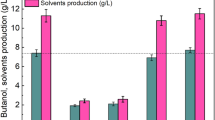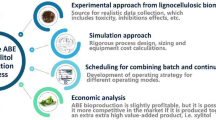Abstract
The reindustrialization of acetone–butanol–ethanol (ABE) fermentation is hampered by its significant production cost, linked to high product inhibition and low product yield. ABE fermentation can be significantly enhanced by integrating in situ liquid–liquid extraction. In this study, hybrid simulations using Excel® and ASPEN Plus® were performed based on solvent-dependent experimental data (product titer, yield and productivity) to consider the physiological response of the microorganism in specific extractive ABE fermentations, and to quantify the energy requirements and the economic improvement of the overall process. Four scenarios, based on two different solvents (2-butyl-1-octanol, 2B1O, and a vegetable oil, VO) applied in batch or fed-batch operation, were compared with the batch conventional process. Total energy demand decreased in all extractive configurations and the greatest energy savings (61%) were reached with the VO-based fed-batch operation. However, the highest profit increase was achieved with 2B1O in fed-batch mode, reducing the minimum butanol selling price by 29% over the base case, along with 34% savings in raw materials and 80% wastewater reduction. The techno–economical solvent-based comparative evaluation is a useful tool to identify key challenges to be tackled when revisiting ABE extractive fermentation.
Graphical abstract









Similar content being viewed by others
Abbreviations
- ∆Glu :
-
Glucose consumption in a fermentation run (kg/m3)
- AT :
-
Total theoretical acetone concentration (kg/m3)
- BT :
-
Total theoretical butanol concentration (kg/m3)
- Bcrit :
-
Critical threshold of aqueous butanol concentration (kg/m3)
- ET :
-
Total theoretical ethanol concentration (kg/m3)
- Fbioreactor :
-
Mass flow rate from the bioreactor (kg/h)
- FDS,out :
-
Mass flow rate from the downstream section (kg/h)
- Fregen :
-
Mass flow rate from the regeneration section (kg/h)
- K:
-
Partition coefficient
- mB :
-
Fixed theoretical mass production rate of butanol (kg/h)
- Pvol,B :
-
Volumetric productivity of a fermentation run (kg B/(m3 h))
- Pmvol,B :
-
Modified volumetric productivity, considering tTC (kg B/(m3 h))
- Sel:
-
Selectivity
- tDS :
-
Time of transfer to downstream section (h)
- tf :
-
Time of a fermentation cycle (h)
- tTC :
-
Total cycle time (h)
- tto :
-
Time of turnover (h)
- QDS :
-
Volumetric rate to downstream section (m3/h)
- Vaq :
-
Aqueous phase volume in the bioreactor (m3)
- Vext :
-
Minimum extractant volume referred to Vaq (m3)
- VTOT :
-
Total aqueous volume required (m3)
- Y:
-
Mass yield (kg product/kg glucose consumed
References
Green EM (2011) Fermentative production of butanol—the industrial perspective. Curr Opin Biotechnol 22(3):337–343
Jones DT, Woods DR (1986) Acetone-butanol fermentation revisited. Microbiol Rev 50(4):484
Xue C, Zhao J, Chen L, Yang ST, Bai F (2017) Recent advances and state-of-the-art strategies in strain and process engineering for biobutanol production by Clostridium acetobutylicum. Biotechnol Adv 35(2):310–322
Mariano AP, Dias MO, Junqueira TL, Cunha MP, Bonomi A, Maciel Filho R (2013) Butanol production in a first-generation Brazilian sugarcane biorefinery: technical aspects and economics of greenfield projects. Bioresour Technol 135:316–323
Dürre P (2011) Fermentative production of butanol—the academic perspective. Curr Opin Biotechnol 22(3):331–336
Xue C, Liu F, Xu M, Zhao J, Chen L, Ren J, Bar F, Yang ST (2016) A novel in situ gas stripping-pervaporation process integrated with acetone-butanol-ethanol fermentation for hyper n-butanol production. Biotechnol Bioeng 113(1):120–129
Yang D, Cheng C, Bao M, Chen L, Bao Y, Xue C (2019) The pervaporative membrane with vertically aligned carbon nanotube nanochannel for enhancing butanol recovery. J Membr Sci 577:51–59
Mariano AP, Keshtkar MJ, Atala DI, Maugeri Filho F, Wolf Maciel MR, Maciel Filho R, Stuart P (2011) Energy requirements for butanol recovery using the flash fermentation technology. Energy Fuels 25(5):2347–2355
Qureshi N, Hughes S, Maddox IS, Cotta MA (2005) Energy-efficient recovery of butanol from model solutions and fermentation broth by adsorption. Bioprocess Biosyst Eng 27(4):215–222
Vane LM (2008) Separation technologies for the recovery and dehydration of alcohols from fermentation broths. Biofuel Bioprod Biorefin 2(6):553–588
Salemme L, Olivieri G, Raganati F, Salatino P, Marzocchella A (2016) Analysis of the energy efficiency of some butanol recovery processes. Chem Eng Trans 49:109–114
Barton WE, Daugulis AJ (1992) Evaluation of solvents for extractive butanol fermentation with Clostridium acetobutylicum and the use of poly (propylene glycol) 1200. Appl Microbiol Biotechnol 36(5):632–639
Groot WJ, Soedjak HS, Donck PB, Van der Lans RGJM, Luyben KCA, Timmer JMK (1990) Butanol recovery from fermentations by liquid-liquid extraction and membrane solvent extraction. Bioprocess Eng 5(5):203–216
Oudshoorn A, Van Der Wielen LA, Straathof AJ (2009) Assessment of options for selective 1-butanol recovery from aqueous solution. Ind Eng Chem Res 48(15):7325–7336
Outram V, Lalander CA, Lee JG, Davis ET, Harvey AP (2016) A comparison of the energy use of in situ product recovery techniques for the Acetone Butanol Ethanol fermentation. Bioresour Technol 220:590–600
Dalle Ave G, Adams TA II (2018) Techno-economic comparison of Acetone-Butanol-Ethanol fermentation using various extractants. Energy Convers Manag 156:288–300
González-Peñas H, Lu-Chau TA, Moreira MT, Lema JM (2015) Assessment of morphological changes of Clostridium acetobutylicum by flow cytometry during acetone/butanol/ethanol extractive fermentation. Biotechnol Lett 37(3):577–584
Gonzalez-Peñas H, Lu-Chau TA, Moreira MT, Lema JM (2014) Solvent screening methodology for in situ ABE extractive fermentation. Appl Microbiol Biotechnol 98(13):5915–5924
Roffler SR, Blanch HW, Wilke CR (1988) In situ extractive fermentation of acetone and butanol. Biotechnol Bioeng 31(2):135–143
Dweck J, Sampaio CMSJ (2004) Analysis of the thermal decomposition of commercial vegetable oils in air by simultaneous TG/DTA. J Therm Anal Calorim 75(2):385–391
Roffler S, Blanch HW, Wilke CR (1987) Extractive fermentation of acetone and butanol: process design and economic evaluation. Biotechnol Prog 3(3):131–140
International Olive Council. https://www.internationaloliveoil.org/estaticos/view/133-eu-producer-prices. (Accessed 6 March 2019)
Engineering Air Liquide. https://www.engineering-airliquide.com/cryocap-h2-cryogenic-co2-separation. (Accessed 6 March 2019)
González-Bravo R, Sánchez-Ramírez E, Quiroz-Ramírez JJ, Segovia-Hernández JG, Lira-Barragán LF, Ponce-Ortega JM (2016) Total heat integration in the biobutanol separation process. Ind Eng Chem Res 55(11):3000–3012
Nitzsche R, Budzinski M, Gröngröft A (2016) Techno-economic assessment of a wood-based biorefinery concept for the production of polymer-grade ethylene, organosolv lignin and fuel. Bioresour Technol 200:928–939
Plan Deploiement Hydrogène (France). https://www.ecologique-solidaire.gouv.fr/sites/default/files/Plan_deploiement_hydrogene.pdf. (Accessed 6 March 2019).
Qureshi N, Saha BC, Cotta MA, Singh V (2013) An economic evaluation of biological conversion of wheat straw to butanol: a biofuel. Energy Convers Manag 65:456–462
ICIS, Chemical Industry News and Chemical Market Intelligence. https://www.icis.com/explore/. (Accessed 6 March 2019).
Laure S, Leschinsky M, Fröhling M, Schultmann F, Unkelbach G (2014) Assessment of an organosolv lignocellulose biorefinery concept based on a material flow analysis of a pilot plant. Cellulose Chem Technol 48(9–10):793–798
Department of Agriculture, Economic Research Service (USAD-ERS). Sugar and Sweeteners Yearbook Tables: Excel Spreadsheets (Table 3). https://www.ers.usda.gov/Briefing/Sugar/data.htm. (Accessed 6 March 2019).
Malmierca S, Díez-Antolínez R, Paniagua AI, Martín M (2017) Technoeconomic study of biobutanol AB production. 2. Process design. Ind Eng Chem Res 56(6):1525–1533
Acknowledgements
This research was supported by the Spanish Government (Ministry of Economy and Competitiveness) through the ERA-IB2 project 2G-Enzymes (PCIN-2015-031). The authors belong to the Galician Competitive Research Group GRC-ED431C 2017/29 and to the CRETUS Strategic Partnership (AGRUP2015/02). All these programs are co-funded by FEDER (EU).
Funding
Ministerio de Economía y Competitividad (Spain). Grant Number PCIN-2015-031.
Author information
Authors and Affiliations
Contributions
HGP and TLC conceived the work. HGP, TLC and GE carried out the process simulations. JL coordinated the study, including the definition of scenarios. HGP was a major contributor in writing the manuscript. All authors read and approved the final manuscript.
Corresponding author
Ethics declarations
Conflict of interest
The authors declare they have no competing interests.
Availability of data and material
The datasets during and/or analyzed during the current study are available from the corresponding author on reasonable request.
Additional information
Publisher's Note
Springer Nature remains neutral with regard to jurisdictional claims in published maps and institutional affiliations.
Electronic supplementary material
Below is the link to the electronic supplementary material.
Rights and permissions
About this article
Cite this article
González-Peñas, H., Lu-Chau, T.A., Eibes, G. et al. Energy requirements and economics of acetone–butanol–ethanol (ABE) extractive fermentation: a solvent-based comparative assessment. Bioprocess Biosyst Eng 43, 2269–2281 (2020). https://doi.org/10.1007/s00449-020-02412-7
Received:
Accepted:
Published:
Issue Date:
DOI: https://doi.org/10.1007/s00449-020-02412-7




